seat adjustment MITSUBISHI ECLIPSE CROSS 2020 Owner's Manual (in English)
[x] Cancel search | Manufacturer: MITSUBISHI, Model Year: 2020, Model line: ECLIPSE CROSS, Model: MITSUBISHI ECLIPSE CROSS 2020Pages: 427, PDF Size: 78.05 MB
Page 38 of 427
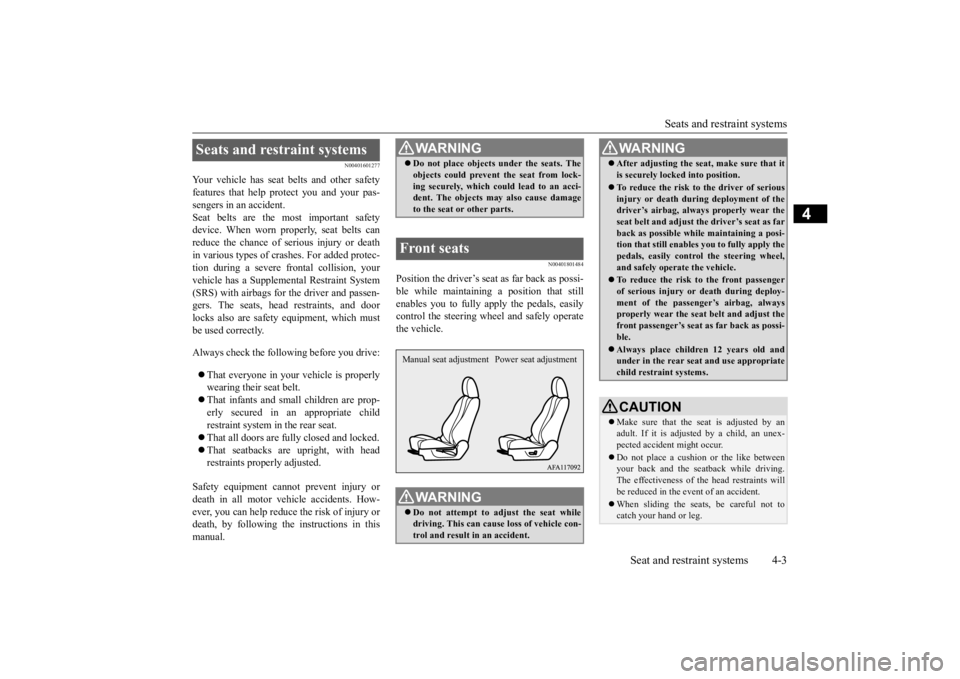
Seats and restraint systems
Seat and restraint systems 4-3
4
N00401601277
Your vehicle has seat belts and other safety features that help protect you and your pas-sengers in an accident. Seat belts are the most important safety device. When worn properly, seat belts canreduce the chance of serious injury or death in various types of crashes. For added protec- tion during a severe frontal collision, yourvehicle has a Supplemental Restraint System(SRS) with airbags for the driver and passen- gers. The seats, head restraints, and door locks also are safety equipment, which mustbe used correctly. Always check the following before you drive: That everyone in your vehicle is properly wearing their seat belt. That infants and small children are prop- erly secured in an appropriate child restraint system in the rear seat. That all doors are fully closed and locked. That seatbacks are upright, with head restraints properly adjusted.
Safety equipment cannot prevent injury or death in all motor vehicle accidents. How-ever, you can help reduce the risk of injury or death, by following the instructions in this manual.
N00401801484
Position the driver’s seat
as far back as possi-
ble while maintaining a position that still enables you to fully apply the pedals, easily control the steering wheel and safely operatethe vehicle.
Seats and restraint systems
WA R N I N G Do not place objects under the seats. The objects could prevent the seat from lock- ing securely, which could lead to an acci- dent. The objects ma
y also cause damage
to the seat or other parts.
Front seats
WA R N I N G Do not attempt to adjust the seat while driving. This can cause loss of vehicle con- trol and result in an accident.Manual seat adjustment Power seat adjustment
After adjusting the seat, make sure that it is securely locked into position. To reduce the risk to the driver of serious injury or death during deployment of thedriver’s airbag, always properly wear the seat belt and adjust th
e driver’s seat as far
back as possible while maintaining a posi-tion that still enables
you to fully apply the
pedals, easily control the steering wheel, and safely operate the vehicle. To reduce the risk to the front passenger of serious injury or death during deploy-ment of the passenger’s airbag, always properly wear the seat belt and adjust the front passenger’s seat as far back as possi-ble. Always place children 12 years old and under in the rear seat and use appropriate child restraint systems.CAUTION Make sure that the seat is adjusted by an adult. If it is adjusted by a child, an unex-pected accident might occur. Do not place a cushion or the like between your back and the seatback while driving. The effectiveness of the head restraints willbe reduced in the event of an accident. When sliding the seats, be careful not to catch your hand or leg.WA R N I N G
BK0277700US.bo
ok 3 ページ 2019年3月8日 金曜日 午前9時23分
Page 39 of 427
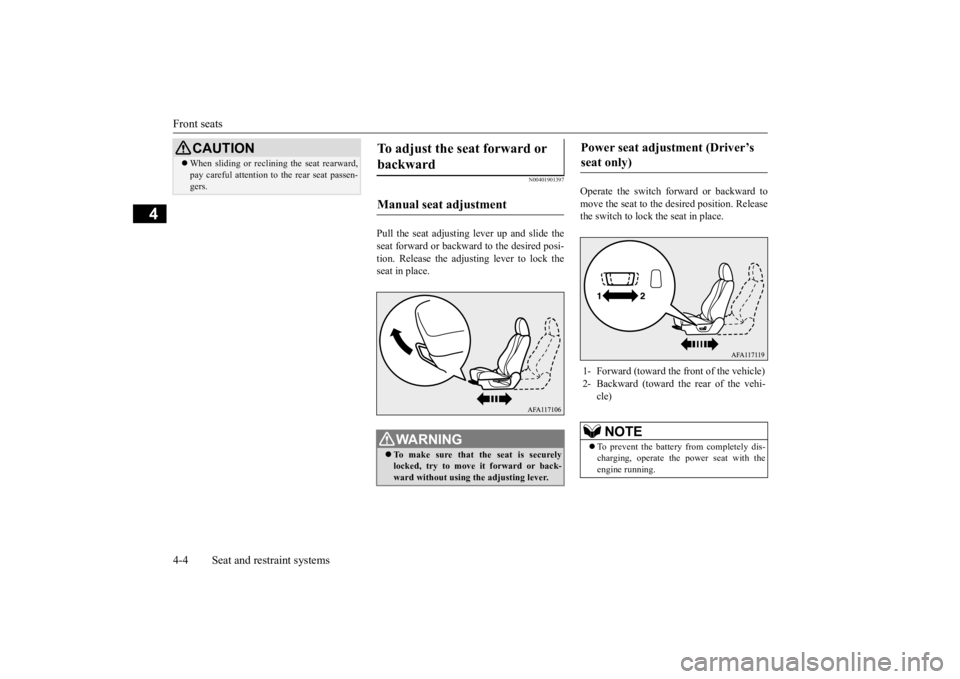
Front seats 4-4 Seat and restraint systems
4
N00401901397
Pull the seat adjusting lever up and slide the seat forward or backward to the desired posi- tion. Release the adjusting lever to lock the seat in place.
Operate the switch forward or backward to move the seat to the desired position. Release the switch to lock the seat in place.
When sliding or reclining the seat rearward, pay careful attention to the rear seat passen- gers.CAUTION
To adjust the seat forward or backward Manual seat adjustment
WA R N I N G To make sure that the seat is securely locked, try to move it forward or back- ward without using the adjusting lever.
Power seat adjustment (Driver’s seat only) 1- Forward (toward the front of the vehicle) 2- Backward (toward the rear of the vehi-
cle)NOTE
To prevent the battery from completely dis- charging, operate the power seat with theengine running.
BK0277700US.bo
ok 4 ページ 2019年3月8日 金曜日 午前9時23分
Page 40 of 427
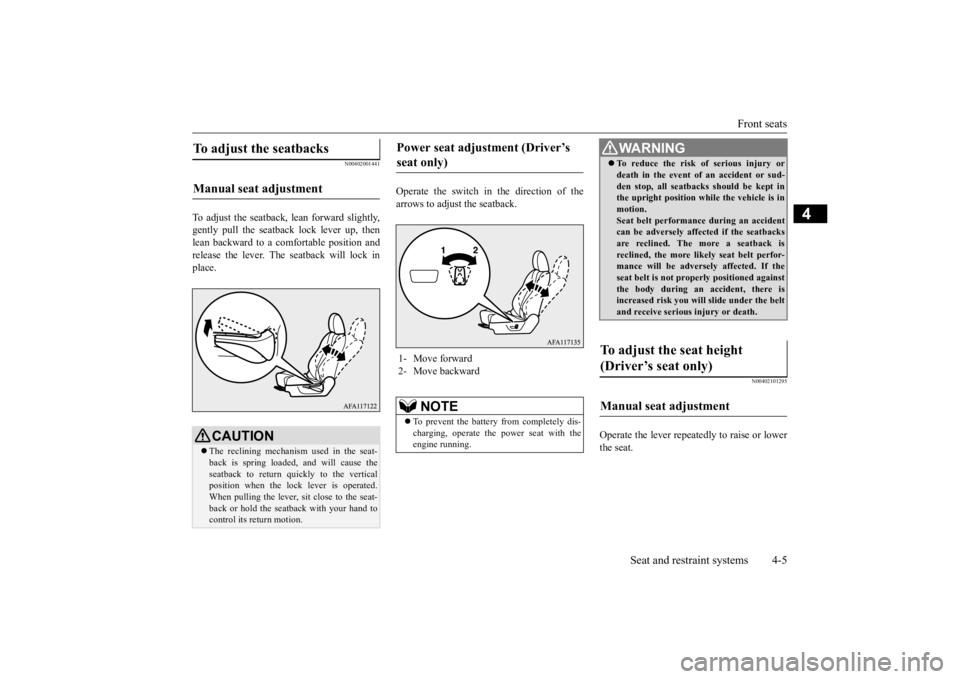
Front seats
Seat and restraint systems 4-5
4
N00402001441
To adjust the seatback, lean forward slightly, gently pull the seatb
ack lock lever up, then
lean backward to a comfortable position and release the lever. The seatback will lock in place.
Operate the switch in the direction of the arrows to adjust the seatback.
N00402101295
Operate the lever repeatedly to raise or lowerthe seat.
To adjust the seatbacks Manual seat adjustment
CAUTION The reclining mechanism used in the seat- back is spring loaded
, and will cause the
seatback to return quickly to the vertical position when the lock lever is operated.When pulling the lever, sit close to the seat- back or hold the seatback with your hand to control its return motion.
Power seat adjustment (Driver’s seat only) 1- Move forward 2- Move backward
NOTE
To prevent the battery from completely dis- charging, operate the power seat with the engine running.
WA R N I N G To reduce the risk of serious injury or death in the event of an accident or sud- den stop, all seatbacks should be kept in the upright position while the vehicle is in motion.Seat belt performance during an accident can be adversely affected if the seatbacks are reclined. The more a seatback isreclined, the more likely seat belt perfor- mance will be adversely affected. If the seat belt is not properly positioned againstthe body during an accident, there is increased risk you will slide under the belt and receive serious injury or death.
To adjust the seat height (Driver’s seat only) Manual seat adjustment
BK0277700US.bo
ok 5 ページ 2019年3月8日 金曜日 午前9時23分
Page 41 of 427
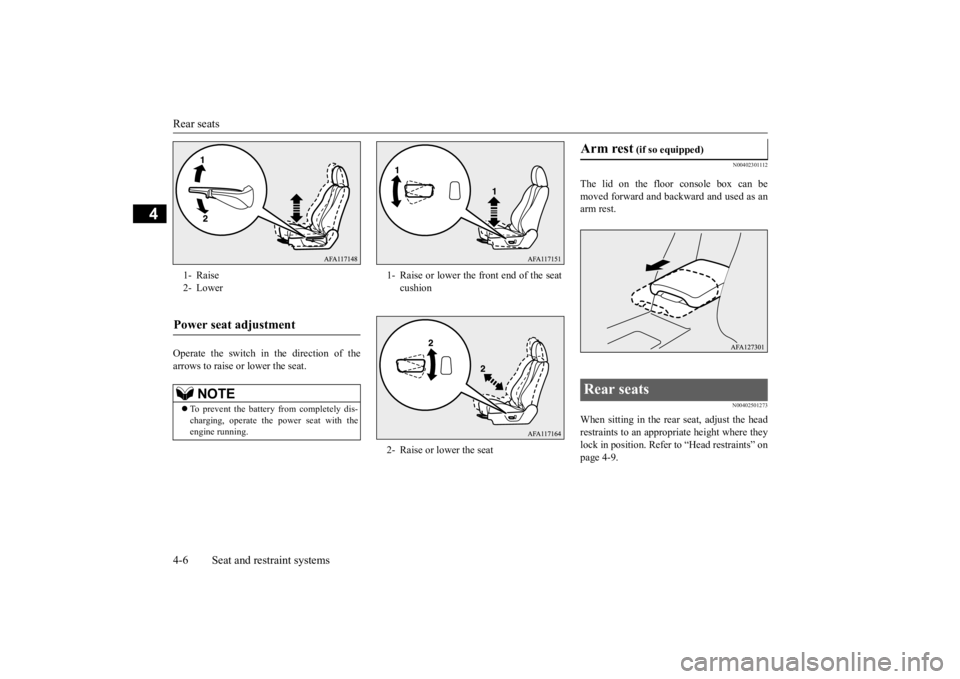
Rear seats 4-6 Seat and restraint systems
4
Operate the switch in the direction of the arrows to raise or lower the seat.
N00402301112
The lid on the floor console box can bemoved forward and backward and used as an arm rest.
N00402501273
When sitting in the rear seat, adjust the head restraints to an appropriate height where they lock in position. Refer to “Head restraints” on page 4-9.
1- Raise 2- LowerPower seat adjustment
NOTE
To prevent the battery from completely dis- charging, operate the power seat with theengine running.
1- Raise or lower the front end of the seat
cushion
2- Raise or lower the seat
Arm rest
(if so equipped)
Rear seats
BK0277700US.bo
ok 6 ページ 2019年3月8日 金曜日 午前9時23分
Page 45 of 427
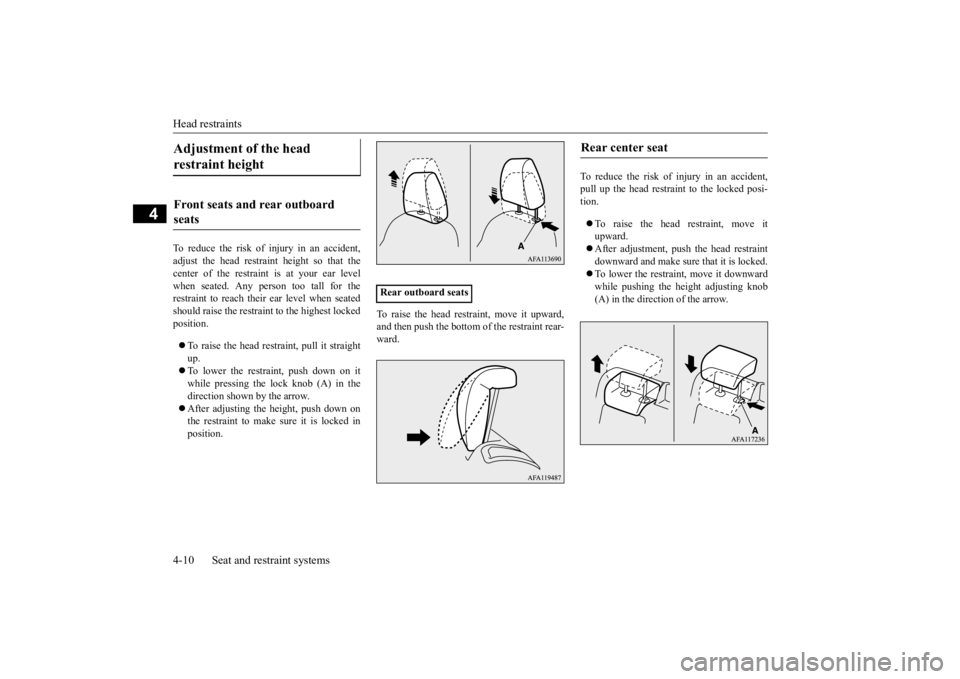
Head restraints 4-10 Seat and restraint systems
4
To reduce the risk of injury in an accident, adjust the head restraint height so that thecenter of the restraint is at your ear levelwhen seated. Any person too tall for the restraint to reach their ear level when seated should raise the restraint to the highest lockedposition. To raise the head restraint, pull it straight up. To lower the restraint, push down on it while pressing the lock knob (A) in the direction shown by the arrow. After adjusting the height, push down on the restraint to make sure it is locked in position.
To raise the head restraint, move it upward, and then push the bottom of the restraint rear-ward.
To reduce the risk of injury in an accident, pull up the head restraint to the locked posi-tion. To raise the head restraint, move it upward. After adjustment, push the head restraint downward and make sure that it is locked. To lower the restraint, move it downward while pushing the height adjusting knob (A) in the direction of the arrow.
Adjustment of the head restraint height Front seats and rear outboard seats
Rear outboard seats
Rear center seat
BK0277700US.bo
ok 10 ページ 2019年3月8日 金曜日 午前9時23分
Page 46 of 427
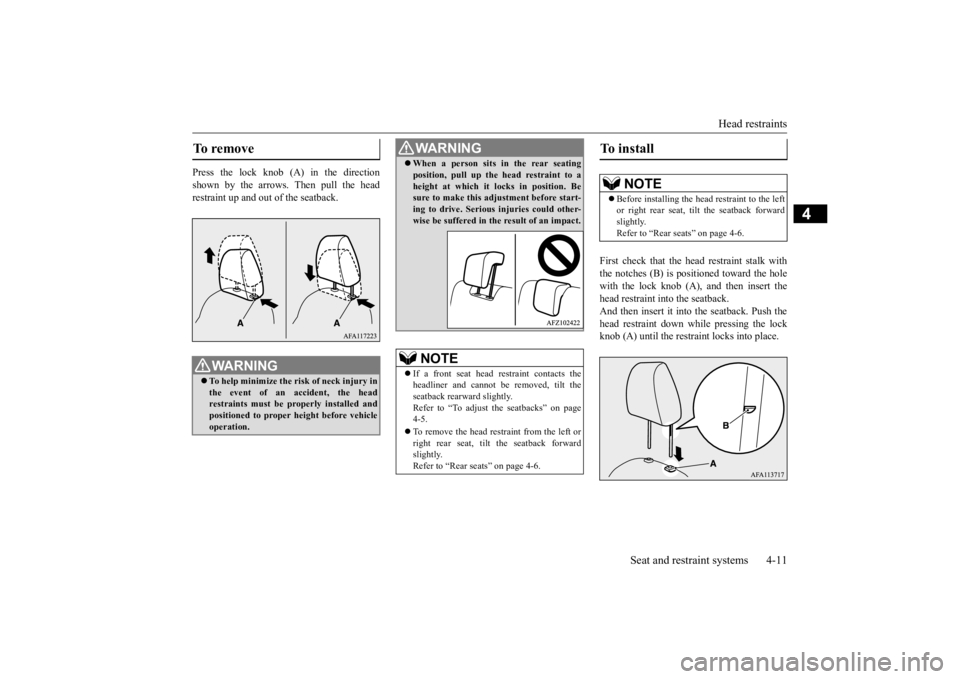
Head restraints
Seat and restraint systems 4-11
4
Press the lock knob (A) in the direction shown by the arrows. Then pull the head restraint up and out of the seatback.
First check that the head restraint stalk with the notches (B) is positioned toward the holewith the lock knob (A), and then insert the head restraint into the seatback. And then insert it into the seatback. Push thehead restraint down while pressing the lock knob (A) until the restraint locks into place.
To remove
WA R N I N G To help minimize the risk of neck injury in the event of an accident, the head restraints must be properly installed and positioned to proper height before vehicleoperation.
WA R N I N G When a person sits in the rear seating position, pull up the head restraint to a height at which it locks in position. Be sure to make this adjustment before start- ing to drive. Serious injuries could other-wise be suffered in th
e result of an impact.
NOTE
If a front seat head restraint contacts the headliner and cannot be removed, tilt the seatback rearward slightly.Refer to “To adjust the seatbacks” on page 4-5. To remove the head restraint from the left or right rear seat, tilt the seatback forward slightly. Refer to “Rear seats” on page 4-6.
To install
NOTE
Before installing the head restraint to the left or right rear seat, tilt the seatback forward slightly. Refer to “Rear seats” on page 4-6.
BK0277700US.bo
ok 11 ページ 2019年3月8日 金曜日 午前9時23分
Page 47 of 427

Making a cargo area 4-12 Seat and restraint systems
4
N00405501131
N00405701162
The rear seatbacks can be folded forward to create an additional cargo area. 1. When folding the left side rear seat, store the seat belt for the
center seating position
of the rear seat. Refer to “Detachable rear center seat belt” on page 4-17.
CAUTION Check that the lock knob (A) is extended out as shown in the illustration. Then pull the head restraint up to make sure that it is locked in place and will not come out of the seatback. The shape and size of the head restraint dif- fers according to the seat. Always use the correct head restraint provided for the seatand do not install the head restraint in the wrong direction.
Making a cargo area
WA R N I N G Never adjust the seats to make a cargo area when the vehicle is in motion or on a slope. The seats could move more than necessary or move suddenly causing aserious accident and/or injury. When returning a seatback to its seating position after folding down, make sure that the seat is firmly secured. If the seat is not secured, it could move causing a seri-ous accident. Do not allow anyone to ride in the cargo area while the vehicle is in motion. People who are not properly seated and restrained can be seriously injured orkilled in an accident.CAUTION In the cargo area, do not load the luggage higher than the top of the seats and makesure that the luggage is firmly secured. Restricted rear vision or flying objects enter- ing the passenger compartment during sud- den braking could result in a serious accident and/or injury. Seats should always be operated by an adult. Seat adjustments by a child could lead to anunexpected accident.
When adjusting the seats, be careful not to catch your hand or leg. Personal injury could result.NOTE
When the seatback of a front seat is reclined, return it to the upright position before driv- ing.
Folding the rear seatbacks for- ward
NOTE
You can separately fold the right and left side of the rear seat.
To fold the seatbacks
CAUTION
BK0277700US.bo
ok 12 ページ 2019年3月8日 金曜日 午前9時23分
Page 137 of 427
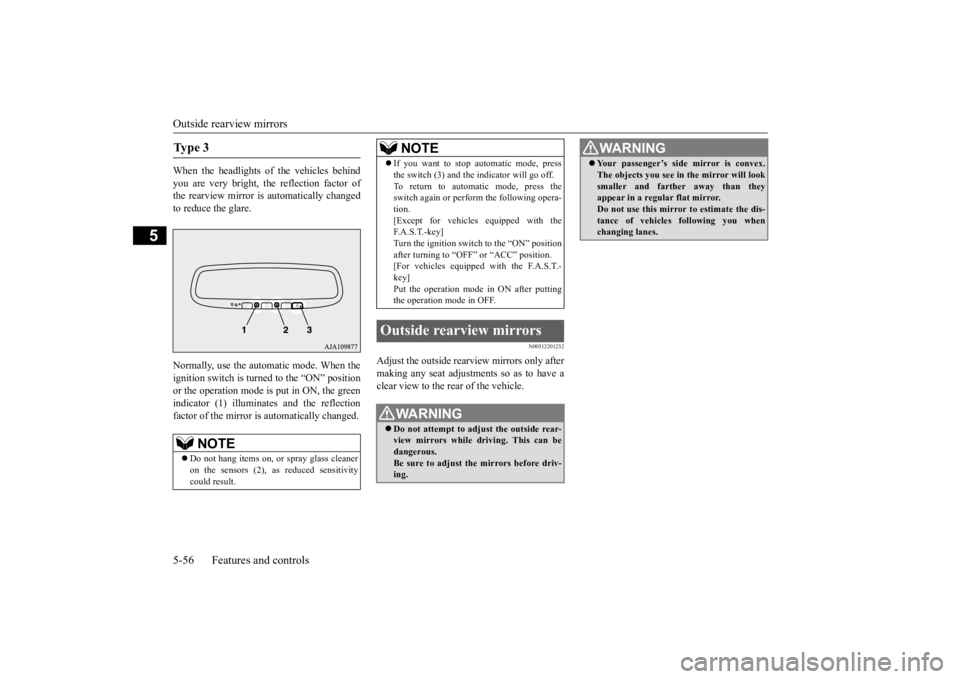
Outside rearview mirrors 5-56 Features and controls
5
When the headlights of the vehicles behind you are very bright, the reflection factor of the rearview mirror is automatically changedto reduce the glare. Normally, use the automatic mode. When the ignition switch is turned to the “ON” position or the operation mode is put in ON, the greenindicator (1) illuminates and the reflectionfactor of the mirror is automatically changed.
N00512201232
Adjust the outside rearview mirrors only aftermaking any seat adjustments so as to have a clear view to the rear of the vehicle.
Ty p e 3
NOTE
Do not hang items on, or spray glass cleaner on the sensors (2), as reduced sensitivity could result.
If you want to stop automatic mode, press the switch (3) and the indicator will go off. To return to automatic mode, press the switch again or perform the following opera- tion.[Except for vehicles equipped with the F. A . S . T. - k e y ] Turn the ignition switch to the “ON” positionafter turning to “OFF” or “ACC” position. [For vehicles equipped with the F.A.S.T.- key]Put the operation mode in ON after putting the operation mode in OFF.
Outside rearview mirrors
WA R N I N G Do not attempt to adjust the outside rear- view mirrors while driving. This can be dangerous. Be sure to adjust the mirrors before driv-ing.NOTE
Your passenger’s side mirror is convex. The objects you see in the mirror will look smaller and farther away than they appear in a regular flat mirror. Do not use this mirror to estimate the dis-tance of vehicles following you when changing lanes.WA R N I N G
BK0277700US.bo
ok 56 ページ 2019年3月8日 金曜日 午前9時23分
Page 421 of 427
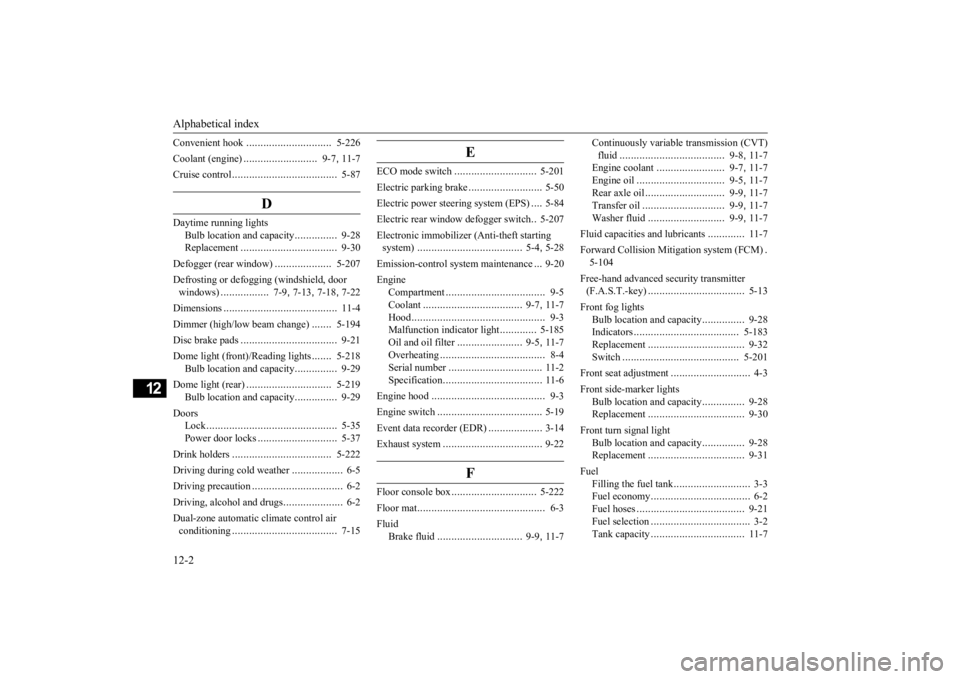
Alphabetical index 12-2
12
Convenient hook
...............
...............
5-226
Coolant (engine)
..........................
9-7
, 11-7
Cruise control
....................
.................
5-87
D
Daytime running lights
Bulb location and capacity
...............
9-28
Replacement
.................
.................
9-30
Defogger (rear window)
....................
5-207
Defrosting or defogging (windshield, door windows)
.................
7-9
, 7-13
, 7-18
, 7-22
Dimensions
...................
.....................
11-4
Dimmer (high/low beam change)
.......
5-194
Disc brake pads
.................
.................
9-21
Dome light (front)/Reading lights
.......
5-218
Bulb location and capacity
...............
9-29
Dome light (rear)
...............
...............
5-219
Bulb location and capacity
...............
9-29
Doors
Lock
......................
........................
5-35
Power door locks
............................
5-37
Drink holders
....................
...............
5-222
Driving during cold weather
..................
6-5
Driving precaution
................
................
6-2
Driving, alcohol and drugs
.....................
6-2
Dual-zone automatic climate control air conditioning
....................
.................
7-15
E
ECO mode switch
.............................
5-201
Electric parking brake
..........................
5-50
Electric power steering system (EPS)
....
5-84
Electric rear window defogger switch
..5-207
Electronic immobilizer (Anti-theft starting system)
.....................
................
5-4
, 5-28
Emission-control system maintenance
...
9-20
Engine
Compartment
..................
.................
9-5
Coolant
...................
................
9-7
, 11-7
Hood
.......................
........................
9-3
Malfunction indicator light
.............
5-185
Oil and oil filter
.......................
9-5
, 11-7
Overheating
....................
.................
8-4
Serial number
.................
................
11-2
Specification
...................
................
11-6
Engine hood
....................
....................
9-3
Engine switch
.....................
................
5-19
Event data recorder (EDR)
...................
3-14
Exhaust system
...................
................
9-22
F
Floor console box
..............................
5-222
Floor mat
.........................
....................
6-3
Fluid
Brake fluid
..............................
9-9
, 11-7
Continuously variable transmission (CVT) fluid
....................
.................
9-8
, 11-7
Engine coolant
........................
9-7
, 11-7
Engine oil
...............................
9-5
, 11-7
Rear axle oil
............................
9-9
, 11-7
Transfer oil
.............................
9-9
, 11-7
Washer fluid
...........................
9-9
, 11-7
Fluid capacities and lubricants
.............
11-7
Forward Collision Mitigation system (FCM)
.
5-104 Free-hand advanced security transmitter (F.A.S.T.-key)
.................
.................
5-13
Front fog lights
Bulb location and capacity
...............
9-28
Indicators
..................
...................
5-183
Replacement
.................
.................
9-32
Switch
......................
...................
5-201
Front seat adjustment
............................
4-3
Front side-marker lights
Bulb location and capacity
...............
9-28
Replacement
.................
.................
9-30
Front turn signal light
Bulb location and capacity
...............
9-28
Replacement
.................
.................
9-31
Fuel
Filling the fuel tank
...........................
3-3
Fuel economy
...................
................
6-2
Fuel hoses
.....................
.................
9-21
Fuel selection
...................
................
3-2
Tank capacity
................
.................
11-7
BK0277700US.bo
ok 2 ページ 2019年3月8日 金曜日 午前9時23分
Page 423 of 427
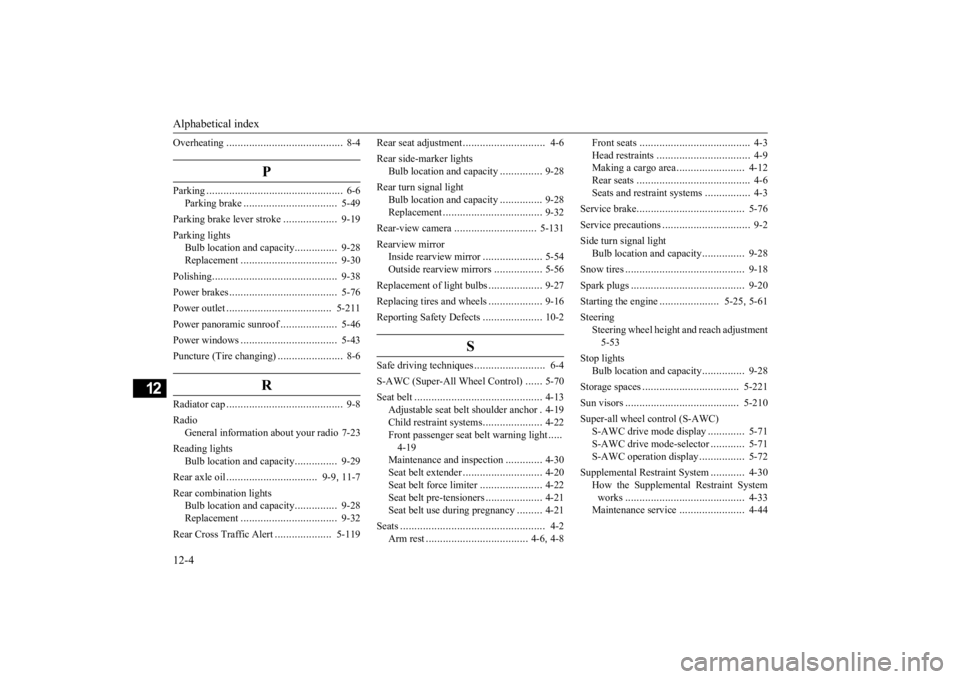
Alphabetical index 12-4
12
Overheating
......................
...................
8-4
P
Parking
.........................
.......................
6-6
Parking brake
................
.................
5-49
Parking brake lever stroke
...................
9-19
Parking lights
Bulb location and capacity
...............
9-28
Replacement
.................
.................
9-30
Polishing
.......................
.....................
9-38
Power brakes
.....................
.................
5-76
Power outlet
..................
...................
5-211
Power panoramic sunroof
....................
5-46
Power windows
.................
.................
5-43
Puncture (Tire changing)
.......................
8-6
R
Radiator cap
......................
...................
9-8
Radio
General information about your radio 7-23
Reading lights
Bulb location and capacity
...............
9-29
Rear axle oil
...............
.................
9-9
, 11-7
Rear combination lights
Bulb location and capacity
...............
9-28
Replacement
.................
.................
9-32
Rear Cross Traffic Alert
....................
5-119
Rear seat adjustment
.............................
4-6
Rear side-marker lights
Bulb location and capacity
...............
9-28
Rear turn signal light
Bulb location and capacity
...............
9-28
Replacement
...................
................
9-32
Rear-view camera
.............................
5-131
Rearview mirror
Inside rearview mirror
.....................
5-54
Outside rearview mirrors
.................
5-56
Replacement of light bulbs
...................
9-27
Replacing tires and wheels
...................
9-16
Reporting Safety Defects
.....................
10-2
S
Safe driving techniques
.........................
6-4
S-AWC (Super-All Wheel Control)
......
5-70
Seat belt
......................
.......................
4-13
Adjustable seat belt shoulder anchor
.4-19
Child restraint systems
.....................
4-22
Front passenger seat belt warning light
.....
4-19 Maintenance and inspection
.............
4-30
Seat belt extender
............................
4-20
Seat belt force limiter
......................
4-22
Seat belt pre-tensioners
....................
4-21
Seat belt use during pregnancy
.........
4-21
Seats
...........................
........................
4-2
Arm rest
..................
..................
4-6
, 4-8
Front seats
....................
...................
4-3
Head restraints
.................
................
4-9
Making a cargo area
........................
4-12
Rear seats
.....................
...................
4-6
Seats and restraint systems
................
4-3
Service brake
.....................
.................
5-76
Service precautions
...............
................
9-2
Side turn signal light
Bulb location and capacity
...............
9-28
Snow tires
.....................
.....................
9-18
Spark plugs
...................
.....................
9-20
Starting the engine
.....................
5-25
, 5-61
Steering
Steering wheel height and reach adjustment5-53
Stop lights
Bulb location and capacity
...............
9-28
Storage spaces
...................
...............
5-221
Sun visors
.....................
...................
5-210
Super-all wheel control (S-AWC)
S-AWC drive mode display
.............
5-71
S-AWC drive mode-selector
............
5-71
S-AWC operation display
................
5-72
Supplemental Restraint System
............
4-30
How the Supplemental Restraint System works
.....................
.....................
4-33
Maintenance service
.......................
4-44
BK0277700US.bo
ok 4 ページ 2019年3月8日 金曜日 午前9時23分